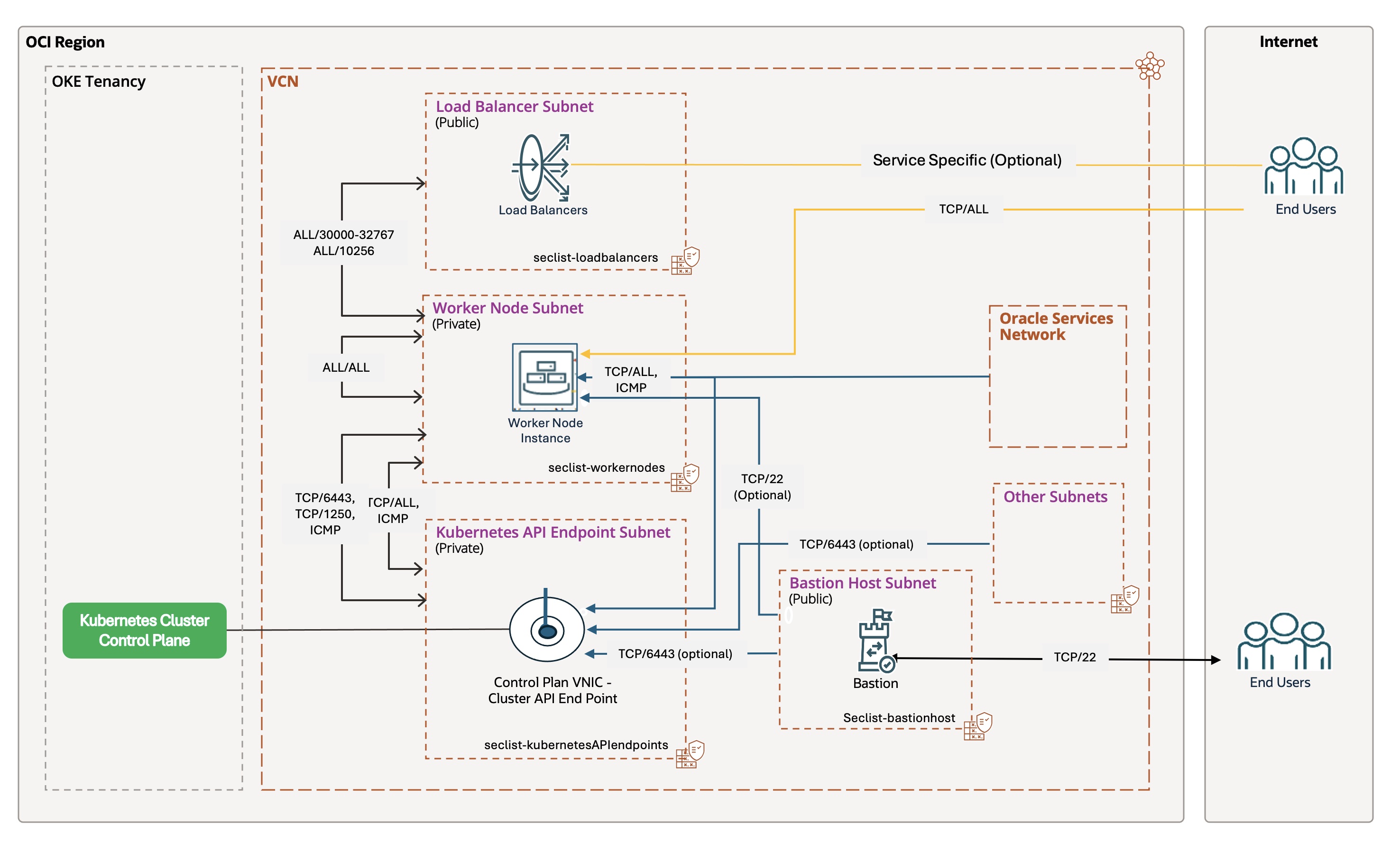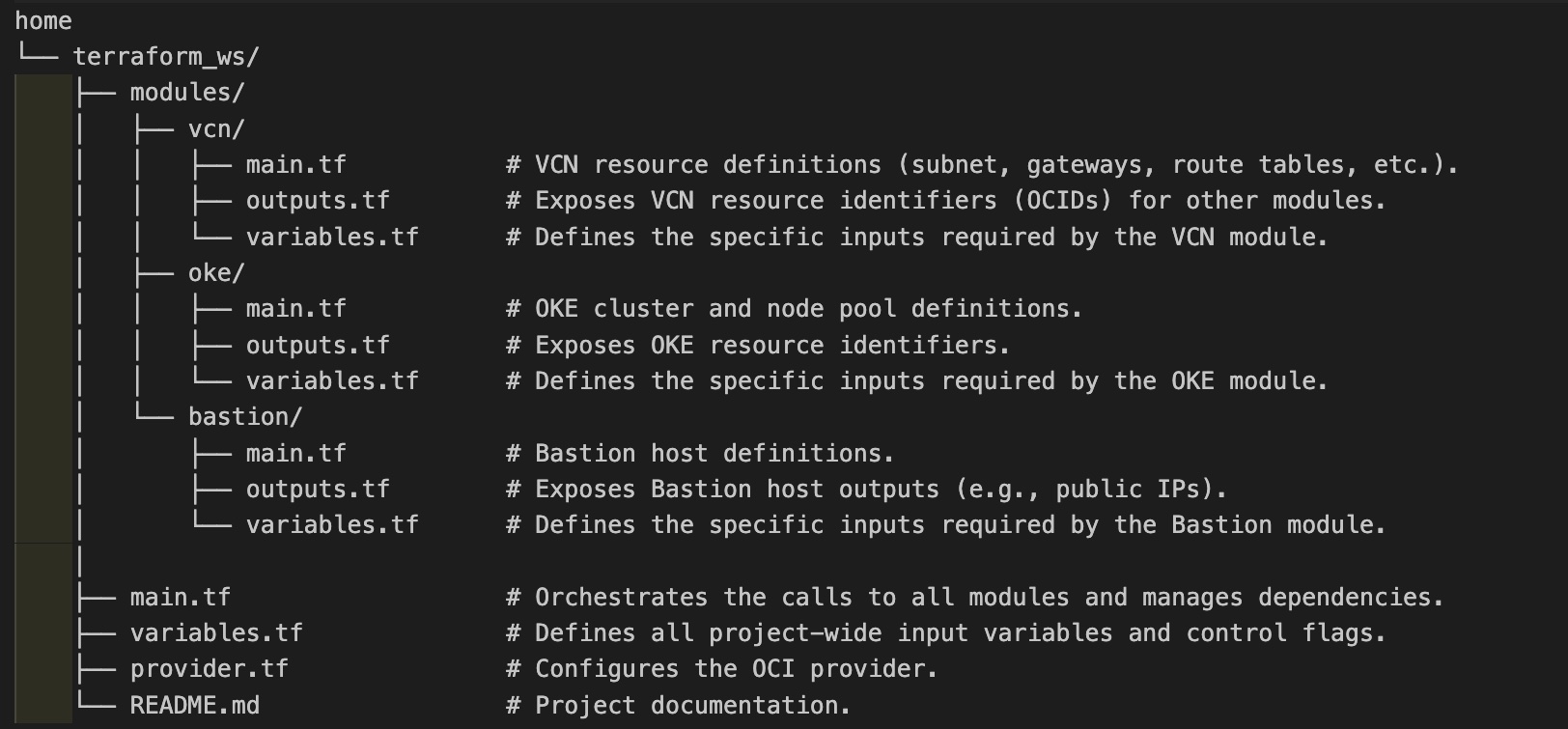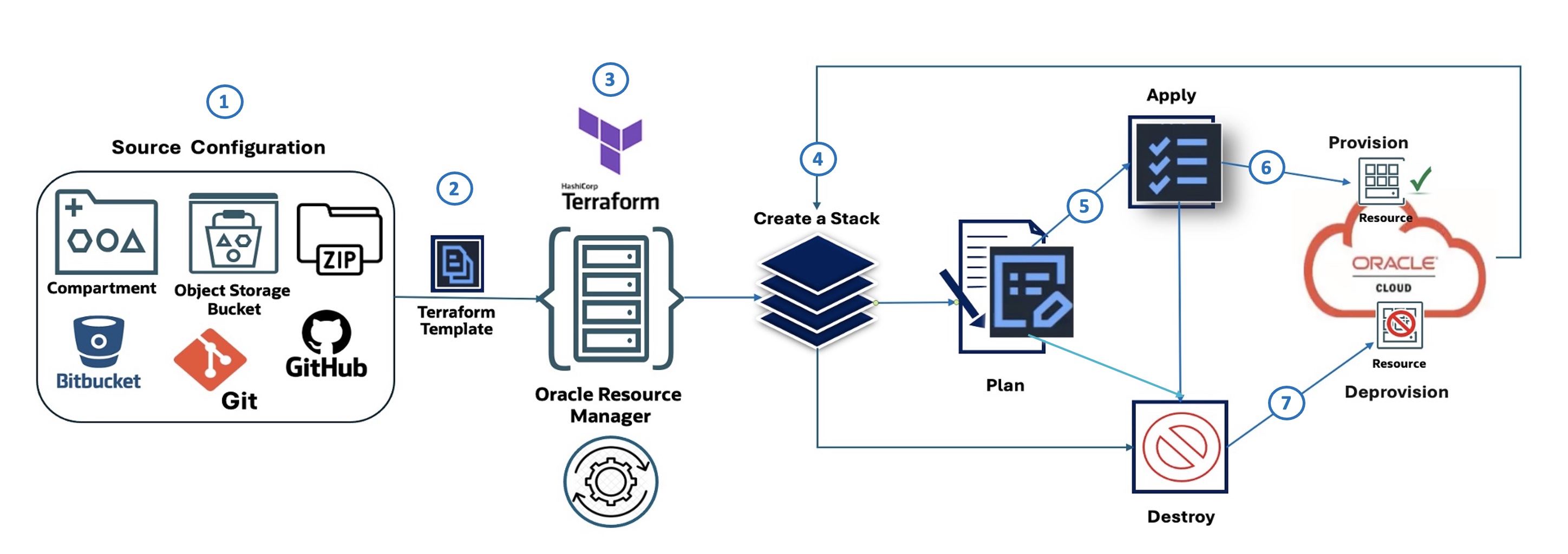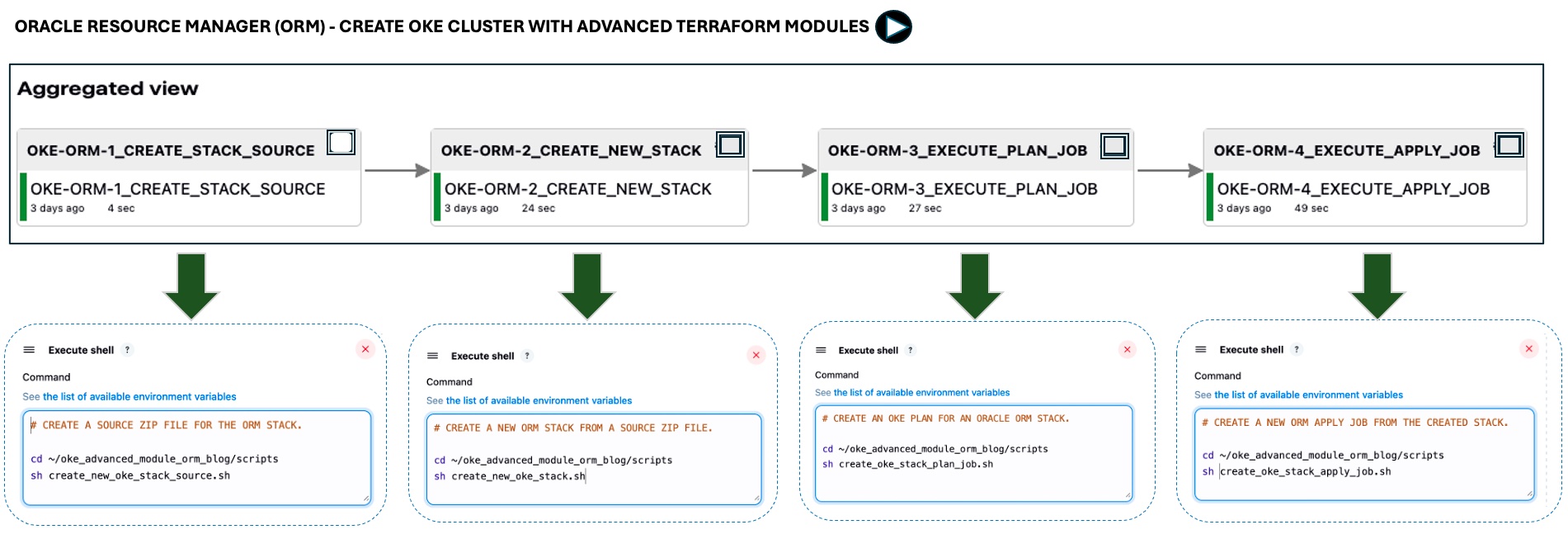Deploy Oracle Cloud Infrastructure Kubernetes Engine (OKE) using Advanced Terraform Modules
Introduction
This is the second tutorial in our Oracle Cloud Infrastructure Kubernetes Engine (OKE) automation series, building on the foundational concepts from the first one, Create Oracle Cloud Infrastructure Kubernetes Engine Cluster using Terraform. In this article, we take OKE deployments to the next level by introducing advanced automation and modular design for provisioning scalable, resilient, and highly customizable environments on Oracle Cloud Infrastructure (OCI).
Designed for Oracle engineers and customers, this guide empowers you to transform a basic Terraform configuration into a structured, reusable module that can be tailored to any deployment size. By leveraging Infrastructure as Code (IaC) principles with Terraform (community version), combined with Jenkins and Oracle Command Line Interface (CLI), we provide a single-click provisioning solution for OKE clusters, their configurations, and automated testing.
This tutorial focuses on four key areas:
- Modular Design and Automation: Build reusable modules for core components such as VCN, OKE Clusters, and Bastion Hosts, with versioning for compatibility to simplify management and to promote code reuse.
- Dynamic Configuration: Manage environment-specific settings (dev, test, prod) from a single codebase for consistent and repeatable deployments.
- Advanced Node Pools: Optimize resource usage and costs with specialized shapes, compatible OKE images, and labels for intelligent workload placement.
- Seamless CI/CD Integration: Automate OKE provisioning and updates using pipelines that integrate Terraform, Jenkins, and OCI CLI for efficient,
one-clickdeployments.
The architecture outlined in this guide uses a tiered network topology to create a secure and scalable foundation. It separates control plane, worker nodes, pods, and load balancer traffic, ensuring flexibility for enterprise workloads of any scale. We’ll demonstrate how to fully automate the provisioning of such environment, including networking, clusters, and node pools, while providing the tools to customize and extend the solution to your needs.
This tutorial assumes an understanding of Kubernetes, networking, and IaC principles, as well as working knowledge of tools such as Terraform, OCI CLI, and Jenkins. By the end, you’ll have the skills to deploy a resilient, high-performing, and scalable OKE environment on OCI, with the flexibility to adapt it to your specific requirements.
Oracle Cloud Infrastructure Kubernetes Engine (OKE) Overview
Even though Oracle Cloud Infrastructure Kubernetes Engine (OKE) is a managed service, successfully running mission-critical workloads requires a deliberate and well-structured architectural approach. Transitioning from a basic setup to a scalable, enterprise-grade environment demands careful planning and the use of Infrastructure as Code (IaC) tools such as Terraform.
Modularization and automation are critical for OKE to ensure scalability, security, and operational efficiency. By leveraging structured modules and automation tools, enterprises can deploy and manage mission-critical workloads with consistency, reduce manual errors, and accelerate time-to-market.
The following diagram illustrates the OKE architecture, highlighting its tiered network topology, private API endpoint, and secure access controls:

For a detailed example of the architecture, refer to the Oracle documentation.
Architectural Considerations
Building a scalable OKE environment involves addressing at least the following key technical challenges:
- Security: Implement a robust security posture using workload identity, network security groups, private API endpoints, and a Web Application Firewall (WAF) for secure isolation and strict traffic control.
- Scalability: Optimize for high availability by distributing nodes across availability domains then fault domains and using the Kubernetes Cluster Autoscaler for dynamic scaling.
- Monitoring and Observability: Integrate with OCI Logging and OCI Logging Analytics for comprehensive monitoring of cluster and pod-level behavior.
Key Design Elements
This modular solution is built on a tiered network architecture, providing a secure and scalable foundation for enterprise workloads on OKE:
- Network Segmentation: Separate the environment with dedicated public and private subnets for the Kubernetes API, worker nodes, pods, and load balancers.
- Controlled Access: Use a private API endpoint for secure control plane access and bastion hosts for managed SSH access.
- Full Automation: Automate the provisioning of the entire environment, including networking, clusters, and node pools, using Terraform, OCI CLI, Bash, and Jenkins for efficient,
single-clickdeployments. - Advanced Operations: Implement persistent volumes and automated node cycling for zero-downtime upgrades.
Building a Modular Terraform Automation for OKE
Transforming a flat Terraform configuration into a structured, modular design is essential for creating repeatable and scalable environments. This approach ensures better organization, code reusability, and maintainability at enterprise scale, with versioning for compatibility and collaboration across teams.
Transformation Process: Flat to Structured Module
Starting from the flat module described in the first tutorial, we refactor the code into a modular design by:
- Restructuring the Directory: Creating child modules (
vcn,oke,bastion) and organizing resources into their respective folders. - Applying Key Principles:
- Structure and Logic: Encapsulate resources in self-contained directories (for example
modules/vcn,modules/oke,modules/bastion) and split monolithic code intomain.tf,variables.tf, andoutputs.tffor readability and maintainability. - Inputs/Outputs and Versioning: Define inputs in
variables.tf, expose outputs inoutputs.tf, and use Terraform module versioning (versionconstraint insource) for seamless data flow and compatibility. - Orchestration: Handle conditional logic such as
countat the root module level, keeping child modules focused on their resources.
- Structure and Logic: Encapsulate resources in self-contained directories (for example
Directory Structure: Flat vs. Modular
Flat Module: A single, monolithic directory with all resources in a few files. Simple for proofs of concept but becomes unmanageable as complexity grows.

Structured Module: Each resource group (VCN, OKE, Bastion) is in its own module directory. The root module orchestrates dependencies and top-level configuration.

Example Modules
- VCN Module (
modules/vcn):- Purpose: Manages network (VCN, subnets, gateways, routes, security lists, etc.).
- Key Files:
variables.tf: Defines inputs such asvcn_cidr_block.main.tf: Contains resource definitions.outputs.tf: Exposes VCN and subnet IDs for other modules.
- OKE Module (
modules/oke):- Purpose: Deploys the OKE cluster and node pools.
- Key Files:
variables.tf: Includesvcn_idand subnet IDs from the VCN module.main.tf: Refactored cluster and node pool definitions.outputs.tf: Exposes OKE cluster and node pool IDs.
- Bastion Module (
modules/bastion):- Purpose: Creates a bastion host for secure access.
- Key Files:
variables.tf: Defines inputs such asbastion_subnet_id.main.tf: Refactored bastion host resources.outputs.tf: Exposes bastion host ID and public IP.
Why Modules?
- Reusability and Collaboration: Modules can be shared across projects, facilitating teamwork.
- Maintainability and Versioning: Updates are applied consistently, reducing drift and ensuring compatibility.
- Scalability and Consistency: Modular designs handle complexity efficiently, standardize deployments, and remove duplication.
Modules Orchestration - root main.tf
The root main.tf orchestrates the deployment of three key modules (modules/vcn, modules/oke, and modules/bastion) in a sequenced manner. Each module is conditionally invoked based on configuration flags (is_vcn_created, is_oke_created, is_bastion_created), providing flexibility in deployment. Below is a simplified version of the orchestration flow, highlighting key module logic without detailing the full main.tf.
Orchestration Flow:
- VCN Module (
modules/vcn):- Provisions the virtual cloud network (VCN) and related subnets (for example, private subnets for Kubernetes API and worker nodes, public subnets for load balancers and bastion).
- Controlled by
is_vcn_created. If enabled, it creates the VCN; otherwise, it assumes an existing VCN (you need to provide its used subnet OCID). - Example snippet:
module "vcn" { count = var.is_vcn_created ? 1 : 0 source = "./modules/vcn?ref=v1.0.0" # Specify the module version # Key variables: compartment_id, vcn_cidr_block, subnet configs, ... }Notes:
- This blog assumes you are creating a new network using the provided VCN module.
- If you want to use an existing VCN, refer to the first blog in this series, Create Oracle Cloud Infrastructure Kubernetes Engine Cluster using Terraform, which introduces the
is_vcn_createdflag. - To add this flexibility here, add/set
is_vcn_createdtofalseand provide the OCID of your VCN along with the OCIDs of subnets for the Kubernetes API endpoint, worker nodes, pods, load balancer, and bastion host.
- OKE Module (
modules/oke):- Deploys the OCI Kubernetes Engine (OKE) cluster, including the control plane and optional managed node pools.
- Depends on the VCN module for subnet IDs. Only invoked if
is_oke_createdandis_vcn_createdare true. - Example snippet:
module "oke" { count = var.is_oke_created && var.is_vcn_created ? 1 : 0 source = "./modules/oke?ref=v1.0.0" # Specify the module version # Key variables: vcn_id, subnet IDs, k8 version, node pool config, ... }
- Bastion Module (
modules/bastion):- Creates a bastion host for secure SSH access to private resources.
- Depends on the VCN module for the public subnet ID. Only invoked if
is_bastion_createdandis_vcn_createdare true. - Example snippet:
module "bastion" { count = var.is_bastion_created && var.is_vcn_created ? 1 : 0 source = "./modules/bastion?ref=v1.0.0" # Specify the module version # Key variables: bastion_subnet_id, SSH keys, parameters... }
Key Notes:
- Module Dependencies: Outputs from the VCN module such as
module.vcn[0].vcn_idare passed as inputs to the OKE and Bastion modules, ensuring a clear dependency chain. - Configuration Logic: Simplified parameter maps (for example,
node_pool_param,bastion_params) streamline configuration and readability. - Versioning: Using version constraints in
sourceensures modules are deployed with the correct and tested versions, ensuring compatibility.
After establishing a modular Terraform structure for OKE, the next step is to automate its deployment. Automation ensures consistency, reduces manual errors, accelerates the provisioning process, and directly improves Time-to-Market (TTM) by enabling rapid delivery of new features and services.
Automations Options
Several tools can automate OKE deployments, including Terraform CLI, OCI Resource Manager (ORM), OCI CLI, Ansible OCI modules, and Helm. However, this guide focuses on the two most prominent infrastructure as code (IaC) approaches in Oracle Cloud Infrastructure (OCI): Terraform CLI and OCI Resource Manager (ORM).
Both tools leverage the same declarative HashiCorp Configuration Language (HCL) but differ in their operational models :
- Terraform CLI: A Command Line Interface tool offering direct control over infrastructure and state files, ideal for individual developers or small teams.
- OCI Resource Manager (ORM): A console-based, fully managed, OCI-native service that centralizes state management and provides a secure, collaborative environment, making it the preferred choice for enterprise-scale deployments.
Let’s explore each option in detail.
Option 1: Deploy OKE Resources with Terraform CLI
The Terraform CLI is ideal when you need complete control over your local environment. It’s best suited for individual developers or small teams who can manage the state file and collaborate effectively using a shared backend. Its portability allows you to run it from any machine: local, VM, container, OCI CloudShell, or CI/CD runners such as Jenkins. However, this flexibility comes with responsibilities, such as managing state files and ensuring consistent local setups across team members.
To begin, download and unzip the Terraform CLI source code package into your Terraform working directory. This package includes main.tf, a terraform.tfvars sample, and detailed module configurations: Download oke_advanced_module.zip.
Deploying OKE with Terraform CLI involves seven key tasks, from configuring variables and networking to setting up the OKE cluster, node pools, and bastion host. Below are the detailed steps to provision and verify your OKE environment using Terraform CLI.
Task 1.1: Configure Terraform Variables
Update the terraform.tfvars file with environment-specific details such as tenancy_ocid, region, compartment_ocid, and network_compartment_ocid. Enable the following flags to control resource creation:
is_vcn_created: Create new or reuse an existing VCN.is_okecluster_created: Provision an OKE cluster.is_nodepool_created: Create one or more node pools.is_bastion_created: Deploy a bastion host.
Task 1.2: Networking Configuration
Define CIDR blocks for the VCN and its subnets:
vcn_cidr_block: VCN CIDR block.k8apiendpoint_private_subnet_cidr_block: Kubernetes API endpoint subnet.workernodes_private_subnet_cidr_block: Worker nodes private subnet.pods_private_subnet_cidr_block: Pods private subnetserviceloadbalancers_public_subnet_cidr_block: Load balancer subnet.bastion_public_subnet_cidr_block: Bastion host subnet.
Task 1.3: OKE Cluster Configuration
- Specify
control_plane_kubernetes_version,worker_nodes_kubernetes_versionandcluster_type(BASIC_CLUSTERorENHANCED_CLUSTER). - Choose a CNI type:
OCI_VCN_IP_NATIVE: Pods get native OCI IPs.FLANNEL_OVERLAY: Pods get IPs from Flannel.
- Set
control_plane_is_publictotrueorfalse.
Task 1.4: Node Pool Configuration
- Define node pools under
node_poolswith:- Shape, version, boot volume size, and AD placement (set 3 ADs if applicable)
- SSH keys for access to the worker nodes in the pool
- Enable
node_cycle_configfor safe node updates:node_cycling_enabled: Enable rolling node replacement.maximum_surgeandmaximum_unavailable: Control scaling during updates (e.g.: 1:0).cycle_modes: ChooseBOOT_VOLUME_REPLACEorINSTANCE_REPLACE.
Note: onlymaximum_unavailableparameter is needed forBOOT_VOLUME_REPLACE.
Task 1.5 Bastion Host Configuration
- If
is_bastion_createdistrue, Terraform provisions a Linux bastion in the public subnet. - Provide:
shape,hostname,boot_volume_size, Linux image OCID, and SSH key paths.
Task 1.6: Run Terraform Commands
Execute the following commands to deploy the infrastructure:
terraform init
terraform validate
terraform plan
terraform apply
After terraform apply completes, your OKE cluster will be provisioned with:
- A VCN with associated networking components (route tables, security lists, gateways), private subnets for worker nodes and the API endpoint, and a public subnet for load balancers.
- An
ENHANCED_CLUSTERwith the specified CNI type and Kubernetes version, a managed node pool, and a bastion host (if configured) for secure SSH access.
Task 1.7: Verification and Cleaning
- Navigate to the OCI Console to verify the cluster configuration.
- Run
terraform destroyto clean up resources when done.
Automating OKE Deployment with Jenkins CI/CD Pipeline
For integrating OKE deployment into DevOps pipelines, Terraform CLI is an excellent choice. Our approach, detailed in Create Oracle Cloud Infrastructure Kubernetes Engine Cluster using Terraform, uses bash scripting to orchestrate the process. This workflow can be consolidated into a Jenkins pipeline for automated execution.
Option 2: Automating OKE with OCI Resource Manager
OCI Resource Manager (ORM) is the ideal choice when you need a managed, cloud-native solution for infrastructure deployments. It’s particularly suited for collaborative, enterprise environments where security, centralized state management, and governance are critical. ORM’s key advantage is that it handles the entire deployment lifecycle within OCI, securely storing the state file and preventing conflicts. This eliminates the need for local setup or managing a shared backend. Furthermore, ORM’s deep integration with the Oracle Cloud allows it to leverage OCI-native features like Identity and Access Management (IAM), enhancing security and control.
In this tutorial, we combine OCI Resource Manager (ORM) with OCI CLI, Bash, and integrate them into Jenkins CI/CD pipelines, offering a complete one-click automation flow with additional DevOps capabilities such as drift detection, secure state management, and team collaboration with versioning for compatibility.
OCI Resource Manager Flow
The following diagram illustrates the ORM workflow, composed of seven steps:

- Source Configuration: Defines the origin of the IaC configuration (for example, OCI Object Storage, GitHub, Zip file).
- Terraform Template: The infrastructure is defined using Terraform.
- OCI Resource Manager: ORM takes the Terraform template and manages the provisioning process.
- Create a Stack: ORM uses the template to create a stack of OCI resources.
- Plan: Generates a plan outlining the actions to be taken.
- Apply: Provisions the resources based on the plan.
- Destroy: Deprovisions the resources when no longer needed.
To deploy an OKE cluster using the new module from OCI Resource Manager (ORM), start by downloading the advanced module for ORM: oke_advanced_module_orm.zip. This version is pre-configured for ORM, with variables set to generic placeholders such as REPLACE_WITH_YOUR_OWN_VARIABLE_VALUE.
Task 2.1: Source Configuration
Update variables.tf with your environment-specific details, such as region, networking CIDRs, and flags to control resource creation (VCN, OKE cluster, node pool, bastion host).
The following bash script creates the ORM resources sources zip file.
- Bash Script:
create_new_oke_stack_source.sh.#!/bin/bash # Define the source directory for the stack src_dir="~/oke_advanced_module_orm/oke_app_src" # Create the zip archive from the source code with overwrite rm -f "$src_dir/stackconfig.zip" cd $src_dir zip -r "../stackconfig.zip" * modules/ # List the contents of the zip file for verification /usr/bin/unzip -l "$src_dir/stackconfig.zip"
Verify your source directory (
~/oke_advanced_module_orm) to make sure a file namedstackconfig.zipcontains all the terraform resource definitions.
Task 2.2: Create OCI Resource Manager Stack
Use the OCI CLI to create an ORM stack. The script below simplifies the process:
Bash Script: create_new_oke_stack.sh.
#!/bin/bash
# Load environment variables (e.g., COMPARTMENT_ID, STACK_NAME, etc.)
source "./env-vars"
# Create the Oracle Resource Manager stack and capture the OCID
stack_output=$(oci resource-manager stack create \
--compartment-id "$COMPARTMENT_ID" --display-name "$STACK_NAME" \
--description "$STACK_DESCRIPTION" --config-source "$CONFIG_SOURCE")
# Extract the OCID of the newly created stack and display it
STACK_OCID=$(echo "$stack_output" | jq -r '.data.id')
echo "Stack OCID: $STACK_OCID"
Task 2.3: Execute Stack Plan Job
Run the Plan job to verify changes before applying them. This dry run provides transparency into the infrastructure changes.
Bash Script: create_oke_stack_plan_job.sh
#!/bin/bash
# Load environment variables (e.g., STACK_OCID)
source "./env-vars"
# Create a plan job for the specified stack
plan_job_output=$(oci resource-manager job create-plan-job \
--stack-id "$STACK_OCID")
# Extract the OCID of the plan job and check for errors
PLAN_JOB_OCID=$(echo "$plan_job_output" | jq -r '.data.id')
if [[ -z "$PLAN_JOB_OCID" ]]; then
echo "Error: Failed to retrieve plan job OCID." >&2
exit 1
fi
echo "Plan job OCID: $PLAN_JOB_OCID"
Task 2.4: Create Apply Job
Provision the OKE cluster and associated resources such as node pool using the Apply job.
Bash Script: create_oke_stack_apply_job.sh
#!/bin/bash
# Load environment variables (e.g., STACK_OCID, EXEC_PLAN_STRATEGY)
source "./env-vars"
# Create an apply job for the specified stack
apply_job_output=$(oci resource-manager job create-apply-job \
--stack-id "$STACK_OCID" \
--execution-plan-strategy "$EXEC_PLAN_STRATEGY")
# Extract the OCID of the apply job and check for errors
APPLY_JOB_OCID=$(echo "$apply_job_output" | jq -r '.data.id')
if [[ -z "$APPLY_JOB_OCID" ]]; then
echo "Error: Failed to retrieve apply job OCID." >&2
exit 1
fi
echo "Apply job OCID: $APPLY_JOB_OCID"
Task 2.5: Execute Destroy Job
Clean up resources by running the Destroy job when the environment is no longer needed.
Bash Script: create_oke_stack_destroy_job.sh
#!/bin/bash
# Load environment variables (e.g., STACK_OCID, EXEC_PLAN_STRATEGY)
source "./env-vars"
# Create an jotroy for the specified stack
apply_job_output=$(oci resource-manager job create-destroy-job \
--stack-id "$STACK_OCID" \
--execution-plan-strategy "$EXEC_PLAN_STRATEGY")
# Extract the OCID of the destroy job and check for errors
DESTROY_JOB_OCID=$(echo "$apply_job_output" | jq -r '.data.id')
if [[ -z "$DESTROY_JOB_OCID" ]]; then
echo "Error: Failed to retrieve destroy job OCID." >&2
exit 1
fi
echo "Apply job OCID: $DESTROY_JOB_OCID"
Automating OKE with Jenkins and OCI Resource Manager
We’ve created a Jenkins pipeline to automate the end-to-end provisioning process (Tasks 2.1–2.4). The pipeline executes bash scripts using the OCI CLI to interact with ORM.
The image below shows the one-click automation for the first four tasks; the destroy step is not included for simplicity.

The pipeline includes source configuration, ORM stack creation, plan generation, resource provisioning, and optional resource deprovisioning.
Next Steps:
Using Terraform for OKE provisioning ensures consistency, automation, and scalability. Modular designs, combined with OCI Resource Manager and CI/CD pipelines, make deployments simpler and easier to maintain. In the next tutorial, we’ll cover best practices for monitoring, security, and production readiness. Building on these foundations, we’ll extend the modules to Oracle AIOps, create an end-to-end OKE blueprint for AI applications, and demonstrate how logging analytics with AI-driven observability can detect anomalies and strengthen container platform security.
Related Links
- Create Oracle Cloud Infrastructure Kubernetes Engine Cluster using Terraform
- Terraform OCI OKE on GitHub
- OCI Resource Manager
Acknowledgments
- Authors: Mahamat Guiagoussou (Master Principal Cloud Architect), Payal Sharma (Senior Cloud Architect), Matthew McDaniel (Staff Cloud Engineer)
More Learning Resources
Explore other labs on docs.oracle.com/learn or access more free learning content on the Oracle Learning YouTube channel. Additionally, visit education.oracle.com/learning-explorer to become an Oracle Learning Explorer.
For product documentation, visit Oracle Help Center.
Deploy Oracle Cloud Infrastructure Kubernetes Engine (OKE) using Advanced Terraform Modules
G43225-02